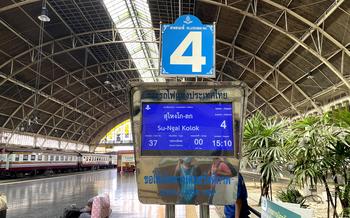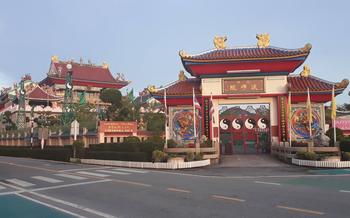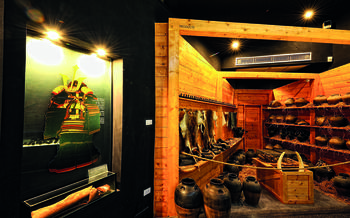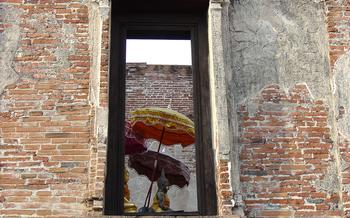
Ban Pa Ao Brass Village
- Exploring the Village: A Journey into Brass Art
- Witnessing the Casting Process: From Molten Metal to Masterpiece
- Learning from the Masters: Workshops and Demonstrations
- Appreciating the Art: A Showcase of Exquisite Craftsmanship
- Shopping for Souvenirs: Taking Home a Piece of Ban Pa Ao
- Dining in Ban Pa Ao: Savoring Local Delights
- Planning Your Visit: Essential Tips for a Smooth Journey
- Cultural Etiquette: Respecting Local Customs and Traditions
- Photography Tips: Capturing the Essence of Ban Pa Ao
- Solo Travel: Embracing the Village's Charm as a Solo Explorer
- Family-Friendly Activities: Creating Memorable Experiences for All Ages
- Responsible Tourism: Supporting the Community and Preserving Heritage
- Insider Tip: Discovering Hidden Gems Beyond the Main Streets
Exploring the Village: A Journey into Brass Art
As you stroll through the narrow streets of Ban Pa Ao, you'll be greeted by the rhythmic clang of hammers and the warm glow of brass foundries. The village is a living tapestry of brass artistry, where artisans showcase their skills and create intricate masterpieces.
Observe the artisans as they work their magic, transforming molten brass into beautiful objects. Watch as they melt the brass in traditional furnaces, carefully pour it into intricate molds, and skillfully shape and polish each piece to reveal its intricate details.
Interact with the friendly locals and learn about their craft. They are eager to share their knowledge and passion, explaining the techniques they use and the history behind their designs. Discover the variety of brass products they create, from household items like cookware and utensils to decorative pieces like sculptures, jewelry, and intricate wall hangings.
Take your time to explore the village, admiring the diverse range of brass products on display. Each piece is a testament to the skill and creativity of the artisans, showcasing the beauty and versatility of brass as a medium.
Witnessing the Casting Process: From Molten Metal to Masterpiece
In Ban Pa Ao, the traditional method of casting brass using molds and furnaces is still practiced, allowing visitors to witness the transformation of raw materials into intricate masterpieces. Artisans begin by melting brass in a furnace, reaching temperatures of over 1,000 degrees Celsius. Once the metal is molten, it is carefully poured into intricate molds, which are often made of clay or sand. The molds have been meticulously carved with intricate designs, ensuring that the final product will be adorned with beautiful patterns.
After the molten brass has been poured, the molds are left to cool and solidify. Once the metal has cooled, the molds are broken away, revealing the intricate details of the cast piece. The artisans then carefully clean and polish the piece, removing any imperfections and bringing out its natural shine. The result is a stunning brass object that showcases the skill and artistry of the Ban Pa Ao craftsmen.
Witnessing the casting process is a mesmerizing experience that provides a glimpse into the skill and dedication required to create these beautiful works of art. Visitors can observe the artisans' precise movements and the intricate details of the molds, gaining a deeper appreciation for the craftsmanship that goes into each piece.
Learning from the Masters: Workshops and Demonstrations
Ban Pa Ao offers a unique opportunity to learn from the masters of brassworking through workshops and demonstrations. These hands-on experiences allow visitors to step into the shoes of an artisan and create their own brass souvenirs under the guidance of skilled craftsmen.
The workshops are designed for beginners and enthusiasts alike, providing a comprehensive introduction to the basics of brassworking. Participants learn about the different tools and techniques used in the craft, from melting and pouring brass to shaping and polishing the finished product.
Under the watchful eyes of experienced artisans, visitors can create their own unique brass souvenirs, such as intricately designed keychains, pendants, or small decorative pieces. The workshops provide a hands-on learning experience that allows visitors to appreciate the skill and artistry involved in brassworking.
By participating in these workshops, visitors not only gain a deeper understanding of the craft but also contribute to preserving the tradition of brassworking in Ban Pa Ao. The workshops empower participants to create their own unique pieces that they can cherish as a reminder of their time in the village and its rich cultural heritage.
Appreciating the Art: A Showcase of Exquisite Craftsmanship
As you stroll through the village, you'll be captivated by the array of finished brass products on display in the workshops and shops. Each piece is a testament to the skill and artistry of the local artisans. From intricate patterns to delicate designs and polished finishes, the brassware reflects the cultural significance and creativity behind Thai craftsmanship.
Admire the intricate patterns and motifs that adorn the brassware, each telling a story about Thai culture and heritage. From traditional floral designs to mythical creatures, the artisans' attention to detail is evident in every piece. The intricate designs and finishes showcase the skill and patience of the artisans, who spend hours meticulously crafting each item.
Take a moment to appreciate the cultural significance of the brassware. In Thai culture, brass is considered a sacred metal, often used in religious ceremonies and rituals. It is also believed to bring good luck and prosperity, making it a popular choice for household items and decorative pieces.
By appreciating the art of brassware in Ban Pa Ao, you not only support the local artisans but also gain a deeper understanding of Thai culture and craftsmanship. Each piece you purchase carries with it a story of tradition, skill, and creativity, making it a unique and cherished souvenir of your visit to this remarkable village.
Shopping for Souvenirs: Taking Home a Piece of Ban Pa Ao
In Ban Pa Ao, shopping for souvenirs is not just about acquiring a memento; it's about supporting the local economy and preserving a rich cultural heritage. As you stroll through the village, you'll find an array of brass products that showcase the skill and creativity of the artisans. From small, intricate trinkets to larger decorative items, each piece is a testament to the village's unique craftsmanship.
When shopping, don't hesitate to bargain with the friendly vendors. This is not only a local custom but also a way to show your respect for their work and contribute to the village's economy. Whether you're looking for a delicate brass necklace, a beautifully engraved bowl, or a majestic brass Buddha statue, you're sure to find something that speaks to you.
Your purchases not only support the livelihood of these talented artisans but also help preserve this ancient tradition for future generations. By bringing a piece of Ban Pa Ao brassware home, you're not just taking a souvenir; you're taking a piece of Thai culture and craftsmanship that will continue to inspire and delight for years to come.
Dining in Ban Pa Ao: Savoring Local Delights
Immerse yourself in the culinary delights of Ban Pa Ao and savor the authentic flavors of Thai cuisine. From humble food stalls to cozy restaurants, the village offers a range of dining options that will tantalize your taste buds. Indulge in regional specialties prepared with fresh, local ingredients, showcasing the culinary heritage of the region. Enjoy a hearty meal surrounded by the charm of the village, soak in the friendly atmosphere, and support the local community by patronizing their businesses. Embrace the opportunity to connect with the locals over shared culinary experiences and create lasting memories of your visit to Ban Pa Ao.
Planning Your Visit: Essential Tips for a Smooth Journey
Before embarking on your journey to Ban Pa Ao, it's crucial to plan ahead to ensure a smooth and enjoyable experience. Here are some essential tips to help you make the most of your visit:
-
Best Time to Visit: The ideal time to visit Ban Pa Ao is during the dry season, which typically lasts from November to April. This period offers pleasant weather with minimal rainfall, making it perfect for exploring the village and its surroundings.
-
Transportation: Reaching Ban Pa Ao is relatively easy. You can take a bus or train from Bangkok, the capital of Thailand, to Ubon Ratchathani, the province where the village is located. From Ubon Ratchathani, you can catch a local bus or hire a taxi to take you to Ban Pa Ao.
-
Accommodation: There are limited accommodation options within Ban Pa Ao itself, but you can find a wider range of hotels and guesthouses in nearby towns such as Ubon Ratchathani or Warin Chamrap. These towns offer more amenities and conveniences for a comfortable stay.
-
Packing Essentials: When packing for your trip, be sure to bring comfortable shoes for walking on the village's cobblestone streets. Sun protection, such as sunglasses, a hat, and sunscreen, is also essential, especially during the hot and sunny months.
Cultural Etiquette: Respecting Local Customs and Traditions
When visiting Ban Pa Ao, it is essential to be mindful of the local customs and traditions to show respect for the community. Here are some guidelines to follow:
-
Greetings: When greeting villagers, it is customary to perform a "wai," a traditional Thai greeting. This involves placing your hands together in a prayer-like position in front of your chest and bowing slightly.
-
Dress Code: Dress modestly and avoid revealing clothing. This is particularly important when visiting temples or other religious sites.
-
Noise Levels: Be mindful of noise levels and avoid making excessive noise, especially in the early morning or late evening.
-
Appreciation: Show appreciation for the artisans' work by purchasing their products or making a donation. This helps support their livelihood and preserves the tradition.
Photography Tips: Capturing the Essence of Ban Pa Ao
Harnessing Natural Light: Embrace the golden hues of sunrise and sunset to create warm and inviting images. Utilize the soft, diffused light of overcast days to capture intricate details and textures.
Exploring Angles and Perspectives: Experiment with various angles to showcase the village's unique charm. Capture the artisans' focused expressions from a low angle to convey their dedication.
Documenting the Artisans' Craft: Freeze the artisans' movements as they pour molten brass, shape intricate designs, and polish their creations. Capture the essence of their craftsmanship through candid shots.
Respecting Privacy: Before capturing portraits of the artisans, seek their permission. Show respect for their work and privacy by asking politely and explaining your intentions.
Composition and Storytelling: Arrange elements within the frame to create visually appealing compositions. Use leading lines, such as narrow streets or rows of workshops, to draw the viewer's eye and tell a story.
Solo Travel: Embracing the Village's Charm as a Solo Explorer
Venturing into Ban Pa Ao as a solo traveler offers a unique opportunity to immerse oneself fully in the village's charm and rich cultural heritage. The village's welcoming atmosphere and friendly locals make it easy for solo travelers to navigate and explore at their own pace. Whether wandering through the narrow streets, admiring the intricate brasswork, or engaging in conversations with the artisans, there's a sense of tranquility and solitude that allows for deep introspection and personal growth.
Solo travelers can take advantage of the opportunity to connect with the locals and fellow travelers, creating meaningful interactions that enrich their experience. The village's small size fosters a sense of community, making it easy to strike up conversations and share stories. Whether dining at local restaurants or participating in workshops, solo travelers can immerse themselves in the village's culture and gain a deeper understanding of the local way of life.
Ban Pa Ao provides a safe and welcoming environment for solo travelers, allowing them to explore independently without compromising their safety or comfort. The village's relaxed pace and friendly atmosphere create a sense of ease, empowering solo travelers to embrace their independence and create lasting memories.
Family-Friendly Activities: Creating Memorable Experiences for All Ages
Ban Pa Ao offers a range of family-friendly activities that cater to visitors of all ages. Families can engage in hands-on activities like brass casting workshops, where they can learn the traditional techniques of brassworking and create their own unique souvenirs. These workshops are designed to be accessible and enjoyable for children and adults alike, providing a memorable and educational experience for the whole family.
Exploring the village's narrow streets together is another delightful activity. Families can admire the intricate brasswork displayed in the shops and workshops, and learn about the history and significance of this traditional craft. Purchasing unique souvenirs for the whole family to cherish as a reminder of their trip adds to the experience, creating lasting memories that can be shared and treasured for years to come.
Ban Pa Ao offers a serene and welcoming environment for families to bond and create lasting memories. Whether it's participating in hands-on workshops, exploring the village together, or simply enjoying the tranquility of the surroundings, families can immerse themselves in the unique culture and heritage of this charming village.
Responsible Tourism: Supporting the Community and Preserving Heritage
As a responsible traveler, it is essential to minimize your environmental impact and support the local community. Choose tour operators that prioritize sustainability and fair trade practices. Respect the village's environment by reducing waste and avoiding littering. Engage with the locals in meaningful ways, such as volunteering your time or attending local events. Promote the village's cultural heritage by sharing your experiences with others and encouraging responsible tourism practices. By supporting the community and preserving its heritage, you contribute to the long-term sustainability of Ban Pa Ao and ensure that future generations can continue to appreciate its unique craftsmanship.
Insider Tip: Discovering Hidden Gems Beyond the Main Streets
To fully immerse yourself in the charm of Ban Pa Ao, venture beyond the main streets and explore the smaller alleys and side streets. Here, you'll discover hidden workshops tucked away from the crowds, where artisans create unique pieces that showcase their mastery.
Interact with the friendly locals and ask them about their craft. They'll be more than happy to share stories about the village's history, traditions, and techniques. You may even get a glimpse into their personal lives and learn about their families and aspirations.
Keep an eye out for hidden gems that offer a glimpse into the village's authentic charm. These could be small shrines, traditional houses, or community gathering places. By exploring off the beaten path, you'll create a truly immersive and memorable experience.
Remember to be respectful and mindful when exploring the village's hidden corners. Ask permission before entering private property or taking photos, and always be considerate of the local customs and traditions.









